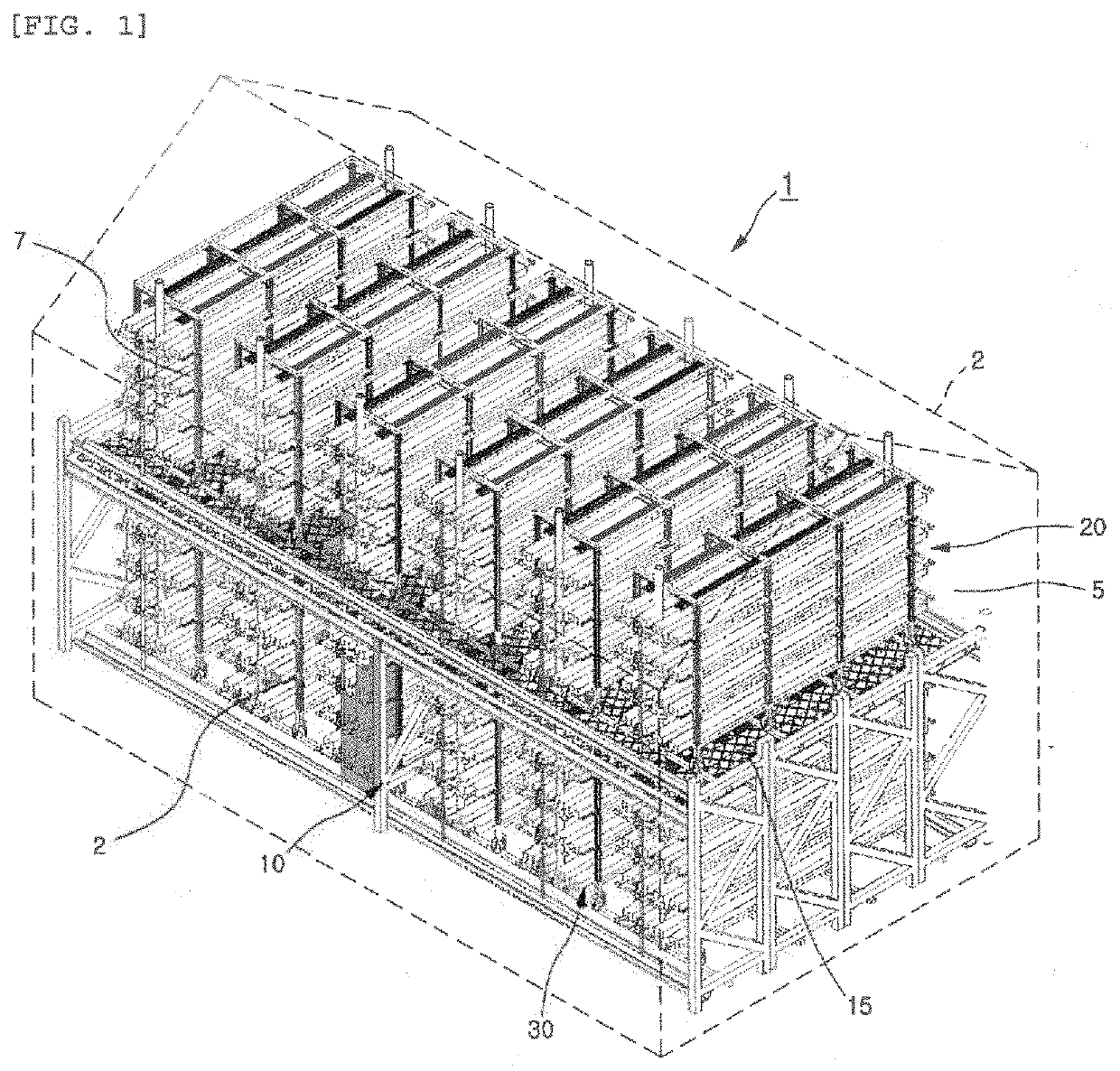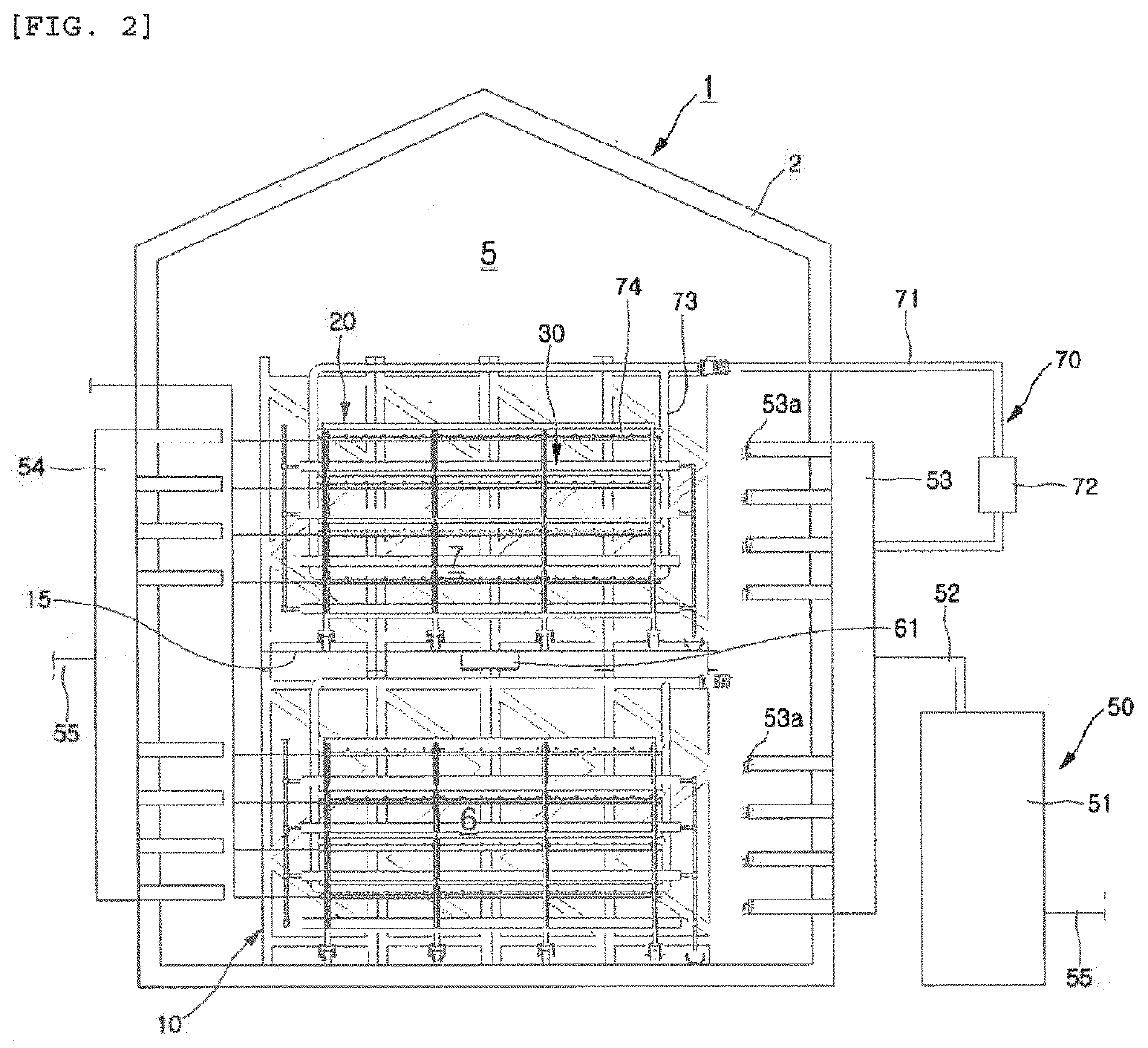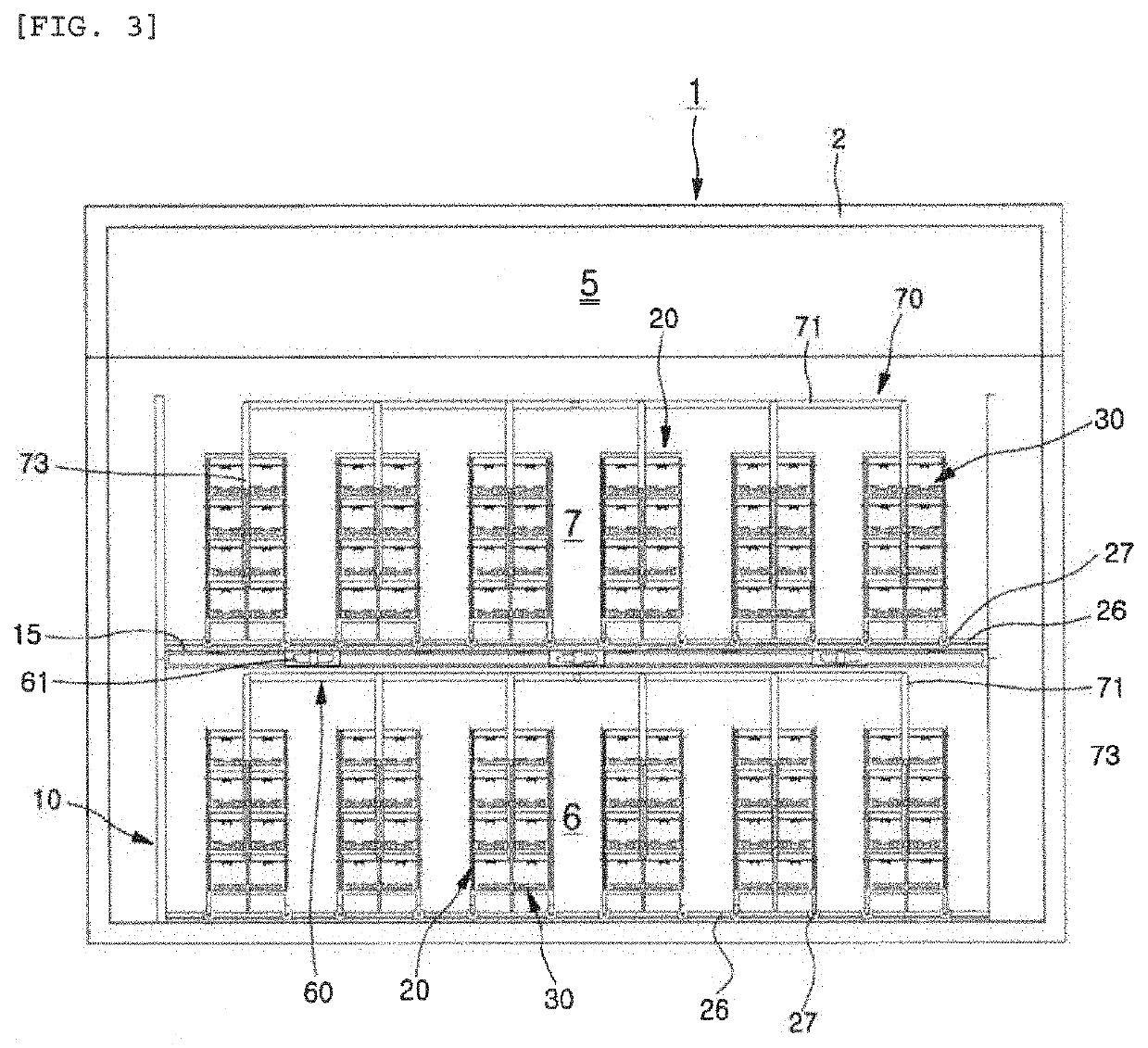Plant factory
a plant factory and plant technology, applied in the field of plant factories, can solve the problems of securing safe food, increasing labor intensity, and most plant factories going bankrupt without producing desired profits, and achieve the effects of maximizing space and energy utilization efficiency, minimizing input resources, and improving productivity
Active Publication Date: 2020-07-09
CHO YOUNG CHAI +1
View PDF0 Cites 26 Cited by
- Summary
- Abstract
- Description
- Claims
- Application Information
AI Technical Summary
Benefits of technology
[0031]According to the plant factory of the present invention, it is possible to provide effects as below. The mesh-shaped floor is formed through the layer division support frames inside the cultivation chamber, and the cultivation chamber is divided into the cultivation layers having a multi-layered structure of two or more layers by the floor, thereby minimizing input resources and maximizing space and energy utilization efficiencies.
[0032]In addition, a horizontal airflow is formed in the respective divided cultivation layers as a whole through the cultivation chamber air circulation supply unit, an interlayer circulation airflow is formed between the respective cultivation layers divided by the mesh-shaped floor through the interlayer air circulation unit, and a vertical downdraft is formed in the respective planting layers divided inside the cultivation table through the cultivation table air supply unit, thereby deviations in the temperature and carbon dioxide (CO2) concentration may be reduced by evenly improving the airflow rate regardless of the place in the cultivation chamber, and productivity may be improved by increasing a net photosynthetic rate and a growth rate of plants.
[0033]Further, the flow of air in the cultivation chamber may be improved through the cultivation chamber air circulation supply unit, the interlayer air circulation unit, and the cultivation table air supply unit, thereby increasing a transpiration rate. In addition, in a process of flowing water (H2O) in a nutrient solution through roots, stems, and leaves of a plant, then passing through final pores of the leaves and foliar boundary layers and moving to an indoor air, inorganic elements necessary for growth are also moved, such that the growth rate of plants may be increased. Further, in relation to physiological symptoms in a growth process of the plants, when growing leafy vegetables such as lettuce, it is possible to solve tip-burn (browning a tip and arou
Problems solved by technology
Nevertheless, most plant factories went bankrupt without producing desired profits due to poor profitability.
At the same time, mankind is facing food shortages due to global warming and abnormal weather phenomena.
In addition, due to the global environmental destruction caused by fine dust, heavy metal contamination, and a spread of diseases such as viruses, securing the safe food is becoming a new issue of mankind.
However, as of 2015, 55% of companies have had a deficit in operation among 191 operated plant factories using artificial light in Japan, and only 23.5% of companies have maintained a break-even point (BEP).
In this situation, plant factories still have great difficulties in terms of profitability.
The largest reason for such a deficit in profitability is a business aspect, but above all, because a level of completion of technologies such as a structure of the plant factory, lighting device, cultivation system, environmental control system, automation and energy saving is low.
In addition, it seems that the deficit may be caused by insufficient selection of cultivars, seedling management, light control management, hydroponic cultivation, growth environment control, and crop production technology, as well as a
Method used
the structure of the environmentally friendly knitted fabric provided by the present invention; figure 2 Flow chart of the yarn wrapping machine for environmentally friendly knitted fabrics and storage devices; image 3 Is the parameter map of the yarn covering machine
View moreImage
Smart Image Click on the blue labels to locate them in the text.
Smart ImageViewing Examples
Examples
Experimental program
Comparison scheme
Effect test
 Login to View More
Login to View More PUM
 Login to View More
Login to View More Abstract
The present invention relates to a plant factory, which provides the following effects. The mesh-shaped floor is formed through the layer division support frame in the cultivation chamber, and the floor is divided into the cultivation layers having a multi-layered structure of two or more layers, thereby minimizing input resources and maximizing space and energy utilization efficiencies. In addition, a horizontal airflow is generally formed in each of the cultivation layers divided by the cultivation chamber air circulation supply unit, and an interlayer circulation airflow is formed between the respective cultivation layers divided by the mesh-shaped floor through the interlayer air circulation unit, and the cultivation table air supply unit creates a planting layer vertical descending air flow divided inside the cultivation table, which evenly improves the airflow rate regardless of the place in the cultivation chamber, reducing the deviation in temperature and carbon dioxide (CO2) concentration, and the net photosynthetic rate and plant may increase productivity by increasing the speed of growth.
Description
TECHNICAL FIELD[0001]The present invention relates to a plant factory, and more specifically to a plant factory capable of ultra-high density cultivating and obtaining high-quality crops with optimum productivity by utilizing a structure for the plant factory and a cultivation system installed in the structure.BACKGROUND ART[0002]As is well known, a plant factory using artificial light was started in Europe in 1957, and passed through a plant factory using natural sunlight that carried out plant cultivation through supplemental lighting, then developed into a fully controlled plant factory using only artificial light in the United States in the 1960s. Thereafter, in 1989, Japan has developed an artificial light source, and placed salad vegetables on the market, thereby having experienced a renaissance of the plant factory and securing plant factory-related technologies.[0003]Nevertheless, most plant factories went bankrupt without producing desired profits due to poor profitability....
Claims
the structure of the environmentally friendly knitted fabric provided by the present invention; figure 2 Flow chart of the yarn wrapping machine for environmentally friendly knitted fabrics and storage devices; image 3 Is the parameter map of the yarn covering machine
Login to View More Application Information
Patent Timeline
 Login to View More
Login to View More IPC IPC(8): A01G9/24A01G9/14A01G7/04A01G9/18
CPCA01G9/247A01G9/24A01G9/18A01G7/045A01G9/1423A01G9/249A01G9/246A01G9/143A01G9/26
Inventor CHO, YOUNG CHAICHO, HAN MOK
Owner CHO YOUNG CHAI
Features
- R&D
- Intellectual Property
- Life Sciences
- Materials
- Tech Scout
Why Patsnap Eureka
- Unparalleled Data Quality
- Higher Quality Content
- 60% Fewer Hallucinations
Social media
Patsnap Eureka Blog
Learn More Browse by: Latest US Patents, China's latest patents, Technical Efficacy Thesaurus, Application Domain, Technology Topic, Popular Technical Reports.
© 2025 PatSnap. All rights reserved.Legal|Privacy policy|Modern Slavery Act Transparency Statement|Sitemap|About US| Contact US: help@patsnap.com



